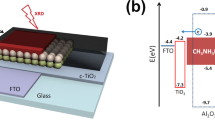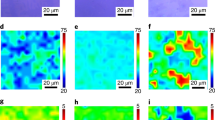Abstract
Carbon-based perovskite solar cells (C-PSCs) are widely accepted as stable, cost-effective photovoltaics. However, C-PSCs have been suffering from relatively low power conversion efficiencies (PCEs) due to severe electrode-related energy loss. Herein, we report the application of a single-atom material (SAM) as the back electrode in C-PSCs. Our Ti1–rGO consists of single titanium (Ti) adatoms anchored on reduced graphene oxide (rGO) in a well-defined Ti1O4-OH configuration capable of tuning the electronic properties of rGO. The downshift of the Fermi level notably minimizes the series resistance of the carbon-based electrode. By combining with an advanced modular cell architecture, a steady-state PCE of up to 20.6% for C-PSCs is finally achieved. Furthermore, the devices without encapsulation retain 98% and 95% of their initial values for 1,300 h under 1 sun of illumination at 25°C and 60 °C, respectively.
This is a preview of subscription content, access via your institution
Access options
Access Nature and 54 other Nature Portfolio journals
Get Nature+, our best-value online-access subscription
$29.99 / 30 days
cancel any time
Subscribe to this journal
Receive 12 digital issues and online access to articles
$119.00 per year
only $9.92 per issue
Buy this article
- Purchase on Springer Link
- Instant access to full article PDF
Prices may be subject to local taxes which are calculated during checkout




Similar content being viewed by others
Data availability
The datasets analysed and generated during the current study are included in the paper and its Supplementary Information. Source data are provided with this paper.
References
NREL. Best research cell efficiency chart. http://www.nrel.gov/pv/cell-efficiency.html (2021).
Khenkin, M. V. et al. Consensus statement for stability assessment and reporting for perovskite photovoltaics based on ISOS procedures. Nat. Energy 5, 35–49 (2020).
Zheng, X. et al. Managing grains and interfaces via ligand anchoring enables 22.3%-efficiency inverted perovskite solar cells. Nat. Energy 5, 131–140 (2020).
Tress, W. et al. Performance of perovskite solar cells under simulated temperature-illumination real-world operating conditions. Nat. Energy 4, 568–574 (2019).
Jiang, Y. et al. Reduction of lead leakage from damaged lead halide perovskite solar modules using self-healing polymer-based encapsulation. Nat. Energy 4, 585–593 (2019).
Guerrero, A. et al. Interfacial degradation of planar lead halide perovskite solar cells. ACS Nano 10, 218–224 (2016).
Rong, Y. et al. Challenges for commercializing perovskite solar cells. Science 361, eaat8235 (2018).
Wang, R. et al. A review of perovskites solar cell stability. Adv. Funct. Mater. 29, 1808843 (2019).
Domanski, K. et al. Not all that glitters is gold: metal-migration-induced degradation in perovskite solar cells. ACS Nano 10, 6306–6314 (2016).
Arora, N. et al. Perovskite solar cells with CuSCN hole extraction layers yield stabilized efficiencies greater than 20%. Science 358, 768–771 (2017).
Rong, Y. et al. Synergy of ammonium chloride and moisture on perovskite crystallization for efficient printable mesoscopic solar cells. Nat. Commun. 8, 14555 (2017).
Mei, A. et al. A hole-conductor-free, fully printable mesoscopic perovskite solar cell with high stability. Science 345, 295–298 (2014).
Zhang, H. Y. et al. Self-adhesive macroporous carbon electrodes for efficient and stable perovskite solar cells. Adv. Funct. Mater. 28, 1802985 (2018).
Zhang, C. et al. Efficient stable graphene-based perovskite solar cells with high flexibility in device assembling via modular architecture design. Energy Environ. Sci. 12, 3585–3594 (2019).
Yan, K. et al. High-performance graphene-based hole conductor-free perovskite solar cells: Schottky junction enhanced hole extraction and electron blocking. Small 11, 2269–2274 (2015).
Zhu, Y. et al. Facile synthesis of nitrogen-doped graphene frameworks for enhanced performance of hole transport material-free perovskite solar cells. J. Mater. Chem. C. 6, 3097–3103 (2018).
Hadadian, M., Smått, J.-H. & Correa-Baena, J.-P. The role of carbon-based materials in enhancing the stability of perovskite solar cells. Energy Environ. Sci. 5, 1377–1407 (2020).
Arora, N. et al. Low-cost and highly efficient carbon-based perovskite solar cells exhibiting excellent long-term operational and UV stability. Small 15, 1904746 (2019).
Zheng, X. et al. Boron doping of multiwalled carbon nanotubes significantly enhances hole extraction in carbon-based perovskite solar cells. Nano Lett. 17, 2496–2505 (2017).
Wu, Z. et al. Highly efficient and stable perovskite solar cells via modification of energy levels at the perovskite/carbon electrode interface. Adv. Mater. 31, 1804284 (2019).
You, P., Liu, Z., Tai, Q., Liu, S. & Yan, F. Efficient semitransparent perovskite solar cells with graphene electrodes. Adv. Mater. 27, 3632–3638 (2015).
Zhou, J. et al. Semi-transparent Cl-doped perovskite solar cells with graphene electrodes for tandem application. Mater. Lett. 220, 82–85 (2018).
Lang, F. et al. In situ graphene doping as a route toward efficient perovskite tandem solar cells. Phys. Status Solidi (A) 213, 1989–1996 (2016).
Chen, M. et al. Boron and phosphorus co-doped carbon counter electrode for efficient hole-conductor-free perovskite solar cell. Chem. Eng. J. 313, 791–800 (2017).
Chee, S. S. et al. Lowering the Schottky barrier height by graphene/Ag electrodes for high-mobility MoS2 field-effect transistors. Adv. Mater. 31, 1804422 (2019).
Kwon, K. C., Choi, K. S. & Kim, S. Y. Increased work function in few-layer graphene sheets via metal chloride doping. Adv. Funct. Mater. 22, 4724–4731 (2012).
Zhou, S. et al. Pd single-atom catalysts on nitrogen-doped graphene for the highly selective photothermal hydrogenation of acetylene to ethylene. Adv. Mater. 31, 1900509 (2019).
Peng, P. et al. A pyrolysis-free path toward superiorly catalytic nitrogen-coordinated single atom. Sci. Adv. 5, eaaw2322 (2019).
Chen, G. et al. Zinc-mediated template synthesis of Fe-N-C electrocatalysts with densely accessible Fe-Nx active sites for efficient oxygen reduction. Adv. Mater. 32, 1907399 (2020).
Jiao, L. & Jiang, H.-L. Metal-organic-framework-based single-atom catalysts for energy applications. Chem. 5, 786–804 (2019).
Xiang, H., Feng, W. & Chen, Y. Single-atom catalysts in catalytic biomedicine. Adv. Mater. 32, 1905994 (2020).
Samantaray, M. K. et al. The comparison between single atom catalysis and surface organometallic catalysis. Chem. Rev. 120, 734–813 (2019).
Huang, L., Chen, J., Gan, L., Wang, J. & Dong, S. Single-atom nanozymes. Sci. Adv. 5, eaav5490 (2019).
Guan, J. et al. Water oxidation on a mononuclear manganese heterogeneous catalyst. Nat. Catal. 1, 870–877 (2018).
Zhang, B. et al. Manganese acting as a high-performance heterogeneous electrocatalyst in carbon dioxide reduction. Nat. Commun. 10, 2980 (2019).
Gu, J., Hsu, C.-S., Bai, L., Chen, H. M. & Hu, X. Atomically dispersed Fe3+ sites catalyze efficient CO2 electroreduction to CO. Science 364, 1091–1094 (2019).
Zhu, H. et al. Tailored amphiphilic molecular mitigators for stable perovskite solar cells with 23.5% efficiency. Adv. Mater. 32, 1907757 (2020).
Wolf, M. & Rauschenbach, H. Series resistance effects on solar cell measurements. Adv. Energy Conv. 3, 455–479 (1963).
Mundhaas, N. et al. Series resistance measurements of perovskite solar cells using Jsc-Voc measurements. Sol. RRL 3, 1800378 (2019).
Zhang, C. et al. Room-temperature solution-processed amorphous NbOx as an electron transport layer in high-efficiency photovoltaics. J. Mater. Chem. A. 6, 17882–17888 (2018).
Cai, X. et al. Revealing atomic structure and oxidation states of dopants in charge-ordered nanoparticles for migration-promoted oxygen-exchange capacity. Chem. Mater. 31, 5769–5777 (2019).
Cueva, P., Hovden, R., Mundy, J. A., Xin, H. L. & Muller, D. A. Data processing for atomic resolution electron energy loss spectroscopy. Microsc. Microanal. 18, 667–675 (2012).
Newville, M. IFEFFIT: interactive XAFS analysis and FEFF fitting. J. Synchrotron Radiat. 8, 322–324 (2001).
Ravel, B. & Newville, M. ATHENA, ARTEMIS, HEPHAESTUS: data analysis for X-ray absorption spectroscopy using IFEFFIT. J. Synchrotron Radiat. 12, 537–541 (2005).
Ankudinov, A. L., Ravel, B., Rehr, J. & Conradson, S. Real-space multiple-scattering calculation and interpretation of x-ray-absorption near-edge structure. Phys. Rev. B. 58, 7565 (1998).
Kresse, G. & Furthmüller, J. Efficiency of ab-initio total energy calculations for metals and semiconductors using a plane-wave basis set. Comput. Mater. Sci. 6, 15–50 (1996).
Kresse, G. & Furthmüller, J. Efficient iterative schemes for ab initio total-energy calculations using a plane-wave basis set. Phys. Rev. B. 54, 11169 (1996).
Acknowledgements
This work was financially supported by the National Natural Science Foundation of China (grant nos. 51872036, 51773025, 11504046), LiaoNing Revitalization Talents Program (grant nos. XLYC2007038, XLYC2008032), Dalian science and technology innovation fund (grant nos. 2018J12GX033, 2019J12GX032) and special funds for science and technology development under the guidance of the central government (grant no. 2021JH6/10500152). N.W. thanks the financial support from the Hong Kong Research Grants Council (project nos. 16306818 and N_HKUST624/19). C.Zhang thanks the Chinese Scholarship Council for their financial support to his in-split PhD study in Switzerland. M.G. thanks the financial support from the European Union’s Horizon 2020 research and innovation programme under grant agreement no. 881603.
Author information
Authors and Affiliations
Contributions
Y.S. and C.Zhang proposed the idea, designed the project and organized the manuscript, C.Zhang carried out the experiments including material characterizations, device fabrication and measurements. M.G. supervised the experimental investigation and manuscript modification. C.Zhu contributed to material design, STEM characterization, structure analysis and manuscript preparation. W.L. conducted XANES and EXAFS measurements and analysed the chemical structure of Ti1–rGO. S.L. prepared Ti1–rGO and conducted DFT calculations. F.T.E. conducted and interpreted the Jsc–Voc measurements. X.C. and N.W. conducted and interpreted the EELS characterization. S.M.Z. helped on manuscript organization and project coordination. K.Z. conducted the HTEM, EDX mapping characterizations and XAFS measurements. J.B. contributed to the analysis of the characterizations around interface. H.Z. helped on the device fabrication. Z.W. modified the manuscript. J.Z analysed the chemical structure of Ti1–rGO. Y.W. contributed to mechanical pressure measurement. J.H., C.X. and H.M. helped with material preparations and XPS/UPS characterizations. All authors contributed to results discussion and writing.
Corresponding authors
Ethics declarations
Competing interests
The authors declare no competing interests.
Additional information
Peer review information Nature Energy thanks Andreas Hinsch and the other, anonymous, reviewer(s) for their contribution to the peer review of this work.
Publisher’s note Springer Nature remains neutral with regard to jurisdictional claims in published maps and institutional affiliations.
Supplementary information
Supplementary Information
Supplementary Figs. 1–21, Notes 1–6 and Tables 1–8.
Source data
Source Data Fig. 2
Numerical data used to generate Fig. 2.
Source Data Fig. 3
Numerical data used to generate Fig. 3a–e.
Source Data Fig. 4
Numerical data used to generate Fig. 4b–g.
Rights and permissions
About this article
Cite this article
Zhang, C., Liang, S., Liu, W. et al. Ti1–graphene single-atom material for improved energy level alignment in perovskite solar cells. Nat Energy 6, 1154–1163 (2021). https://doi.org/10.1038/s41560-021-00944-0
Received:
Accepted:
Published:
Issue Date:
DOI: https://doi.org/10.1038/s41560-021-00944-0
This article is cited by
-
Infrared-reflective ultrathin-metal-film-based transparent electrode with ultralow optical loss for high efficiency in solar cells
Scientific Reports (2024)
-
Accurate atomic scanning transmission electron microscopy analysis enabled by deep learning
Nano Research (2024)
-
Stabilization of 3D/2D perovskite heterostructures via inhibition of ion diffusion by cross-linked polymers for solar cells with improved performance
Nature Energy (2023)
-
Inverted perovskite solar cells with over 2,000 h operational stability at 85 °C using fixed charge passivation
Nature Energy (2023)
-
Next-generation applications for integrated perovskite solar cells
Communications Materials (2023)



